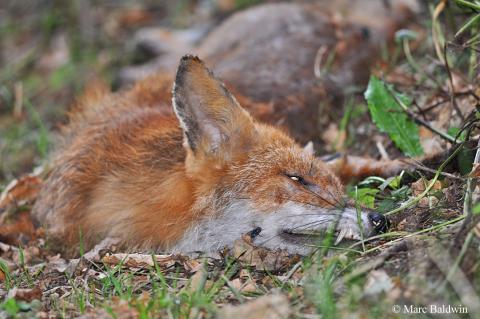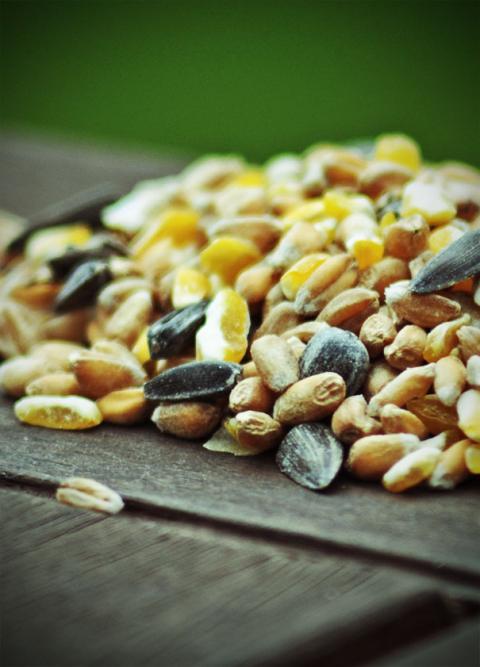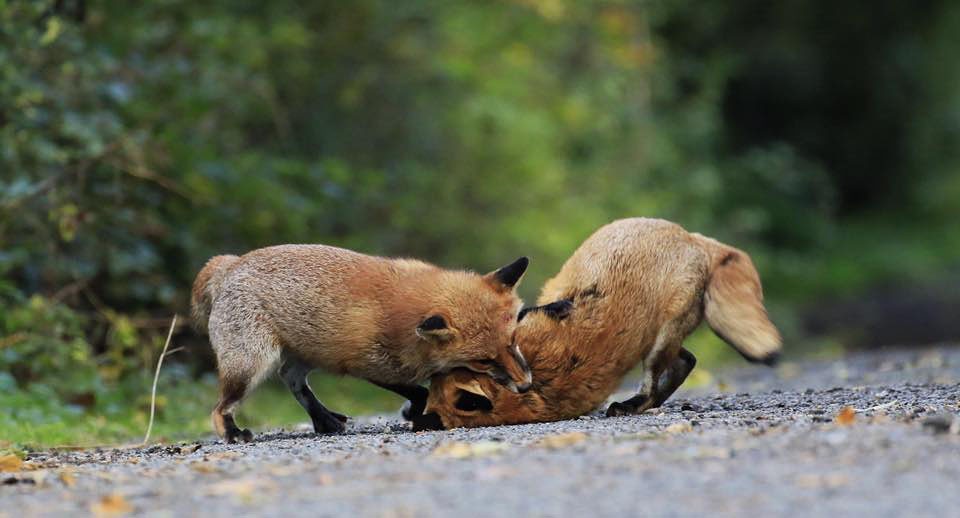Red Fox Mortality & Disability
Mortality rate varies considerably according to a host of factors, including age class, region, season, habitat, food availability and population density. Over large parts of their range, foxes are also persecuted by humans as a result of the damage they do (and their potential to do damage) to livestock. There are laws in place that regulate how foxes can be killed in Britain -- they cannot, for example, be poisoned or gassed -- but there is no law against killing this species. Indeed, there is no closed season for foxes so anybody with the appropriate firearms licence and (depending on location) permission can do so at any time of the year. Furthermore, there is no requirement to record the number of foxes shot, which makes it impossible to obtain absolute values for the number of foxes killed in the UK each year. There are, however, some estimates available.
In their 2005 paper to the journal Animal Welfare, Bristol University biologists Stephen Harris and Phil Baker estimate that about 80,000 foxes are shot each year; roughly half by gamekeepers. In the Game Conservancy Trust's 2000 report, Fox Control in the Countryside, Jonathan Reynolds notes that, of the foxes killed by Britain's gamekeepers each year, about 30% are taken by lamping (i.e., night-shooting with a high-powered, centre-fire rifle and spotlight), while 25% are caught in snares and a further 25% culled at cubbing earths (apparently 80% of foxes killed here are female); a further 10% are killed by terriers. I suspect these ratios have changed since the introduction of the Hunting Act (2004), which made it illegal to hunt foxes with a pack of hounds -- a greater proportion of foxes are now likely to be shot.
Regardless of the method of control, it is clear that a large number of foxes are born each year and a large number die. Indeed, the Bristol University team have calculated that Britain's fox population swells to an estimated 675,000 individuals in late-spring, only to have dropped back down to around 258,000 individuals by the time the breeding season commences in the winter. In other words, some 425,000 cubs are born each year and a similar number of foxes (a mix of adults and cubs) die.

In Britain an unknown number of foxes are killed by predators (see Predators) and disease (see Parasites and Diseases) each year, while an estimated 100,000 are killed by vehicles; during his studies in Oxford city, David Macdonald found that 60% of foxes were run-over. Indeed, the Bristol biologists suggest that road traffic collisions are probably the single biggest cause of fox mortality in this country, with such collisions more prevalent in urban than rural areas. In Bristol, three-month and seven-month old animals are apparently most susceptible to traffic collisions and this is associated with an increase in the cub's ranging behaviour around the den site at these ages. In the recent Channel 4 documentary series, Foxes Live, it was estimated that pest controllers kill about 10,000 foxes in urban areas every year, although to the best of my knowledge there are no formal figures.
The mortality among cubs is typically high and may exceed that of adults. In their summary of urban foxes published in 2010, Carl Soulsbury and his colleagues gave annual mortality rates for juveniles in urban areas of 54-57% (Bristol), 64-66% (London) and 66-68% (Illinois), with comparable figures for adults of 50%, 53-56% and 61-74%, respectively. Elsewhere, the Bristol biologists have estimated that some 20% of cubs die underground (i.e., before about six weeks old), some, it is suspected, as a result of fights with litter-mates as the social hierarchy becomes established. Indeed, a study on the cub mortality in Bristol found that 15% of four-week-old cubs died, of 1000 cubs born, 650 (65%) survived to sub-adult status and only 390 (39%) made it to adulthood.
In Northern Ireland, during the mid-to-late 1960s, James Fairley found that 60-75% of cubs died in their first year while, in Russia, Nikolai Korytin found that 52% of cubs survived to six-months old, about 33% of juveniles made it to adulthood and 44% of adults died each year; cub survival in Russia was impacted more by extra-population factors (e.g., food availability) than by internal factors (e.g., density). Overall, in their 2004 review of the Red fox in Canids: Foxes, Wolves, Jackals and Dogs, David Macdonald and Jonathan Reynolds note that, globally:
" ... roughly 75% of foxes die in their first year, and thereafter mortality is approximately 50% in each adult year."
Causes of death in foxes
Some specific causes of fox mortality are discussed separately elsewhere (i.e., Parasites and Diseases and Predators), but there are many other sources. Death by misadventure is a well-known source of mortality, especially among cubs. Indeed, the aforementioned Bristol University study on cub survival found that some died when they became entangled in netting and washing lines or fell into ponds and swimming pools; other major sources of mortality included hypothermia, attack by domestic dogs, attack by badgers, and the death of the vixen. Foxes will scavenge and are consequently exposed to the associated risks. I have seen a recent (May 2023) report of a fox having apparently died having eaten a balloon that became lodged in its gastrointestinal tract, although I have not seen the autopsy report. More recently, in March 2024, Wild Aid animal hospital in Surrey took in a vixen who had been found collapsed and that died in transit. A post mortem revealed a tangled mass of what appeared to be dog poo bags in the digestive tract, a finding that coincides with a study by Cristian Waggershauser and colleagues in Scotland that suggested foxes were eating dog faeces, which are high in calories. Given the frequency with which discarded "poo bags" can be found in parts of Britain, this may represent a potential threat in some populations. Additionally, there is at least one well-known case of large-scale secondary poisoning (i.e., caused by eating poisoned animals).
Poisoning & contamination
The substantial die-off of foxes, pigeons and pheasants in Peterborough during November 1959 (and more widespread cases from across England until May 1960) were attributed to poison. In a relatively small arable area of eastern England alone, some 1,300 foxes died over a five month period. Several foxes were seen staggering around in broad daylight apparently blind (one vixen in Essex "blundered into" a gamekeeper and another was found wandering around the Master of the Heythrop hounds' yard); most were, nonetheless, in good body condition, suggesting they weren't starving.

Thorough investigation by a team at the Canine Health Centre (part of the Animal Health Trust) in Suffolk established that the foxes had died through indirect poisoning. Corn in the affected regions was being sprayed with chlorinated hydrocarbon insecticides (chemicals used to kill crop-eating insect pests) and the local birds were being killed when they ate the corn; the foxes had died after scavenging the poisoned birds. Similarly, a study in Europe between 1963 and 1971 found that 20 of the 32 foxes tested for thallium poisoning had sufficient quantities in their system for it to have been the cause of their death; thallium was commonly used in rodent poisons.
More recently, of 34 foxes submitted to the Toxicology Laboratory of the Veterinary School in Lyon, France between 1991 and 1994, 31 had been poisoned by rodenticides, with high levels of the rodent poison bromadiolone in their livers. Foxes may also accumulate heavy metals and various toxic chemicals (e.g., PCBs, pesticides, etc.) and a study of 192 foxes collected from the Swiss city of Zurich and its suburbs during 1999 and 2000 found PCBs in the fatty tissues of all animals along with various pesticides; 70% tested positive for dieldrin, while 34% contained traces of DDT. The study, published in Environmental Health Perspectives during 2003, also found no significant difference between the levels of these compounds in urban and rural foxes, although they did establish higher concentrations in juveniles than in adults; the authors suggest that these fat-soluble compounds may be passed to cubs in the vixen's milk (indeed, adult females had lower PCB levels than adult males, supporting this theory).
Concentrations of heavy metals (e.g., cadmium, lead, copper, zinc, etc.) appear to vary according to habitat and a 2001 study by Swiss biologists found that urban foxes had higher lead, but lower cadmium, concentrations in their liver and kidney tissues than surrounding suburban and rural animals. The accumulation of cadmium was considered to be picked up from the soil by invertebrates (esp. earthworms) and plants (fruit) and transferred to suburban and rural animals that are eating more wild food; urban animals were less affected because their diet contained large quantities of human food, which is only permitted for consumption if cadmium is below trace levels. Lead was presumably accumulated from industrial outputs (e.g., manufacturing), explaining the higher concentrations in urban environments. What impact these chemicals have on the foxes are unknown, but in humans and other species they have been linked with cancers, neurological diseases and reproductive failure.
Fox vs. fox
Foxes may occasionally fall foul of other foxes, with both infanticide (killing of young) and cannibalism known in this species (see infanticide QA for more details). Fights between foxes over territory or access to mates are common and can be serious. Indeed, the popular literature is replete with descriptions of fights between foxes, often involving the stereotypical "fox trotting" behaviour where the two animals rear up on their hind legs and attempt to push each other over (See: Behaviour and Sociality). In most cases, these fights are fast, aggressive and noisy, but generally do little permanent damage. In some -- apparently quite rare -- cases, however, such disputes can prove fatal.

In a 1987 paper to the Journal of Applied Ecology, Stephen Harris and Gerald Smith report that fights with other foxes accounted for about 3% of the deaths in a low-density population in Bristol; unsurprisingly, this rose to 7% in a nearby high-density population. Harris and Smith also note that adult fox mortality increased during the breeding season, when they're more mobile and more likely to encroach on another animal's territory. Similarly, in a short paper to the Veterinary Record during 1995, M.A.F.F. biologists Paul Duff and B. Hunt report that, of 27 foxes autopsied between 1989 and 1994, seven (26%) adult deaths were associated with deep bite wounds believed to have been inflicted by other foxes and all occurred between January and February (the breeding season); most casualties were males and bite wounds tended to be focused around the face and back of the neck). In one particular vixen, Duff and Hunt found evidence of a particularly serious attack, with multiple bite wounds and skin lacerations.
Fox fights are frequently heard, but rarely seen. Occasionally, however, the attack is captured on film. One such incident occurred during April 2005 in Chertsey, Surrey between midnight and 5:30am. The following is an extract of an e-mail I received from a reader describing the incident that took place in his driveway (reproduced with his permission):
"We went to take the children to school and when we stepped out of the front door, the car was surrounded on three sides by blood on the beige block we had recently had put down. The car too had lots of blood on the lower door sills and beneath the front grill and bumper where something had been dragged or carried bleeding around the car. The trail continued around the drive and car to the front "walk through" gate and then disappeared along the public footpath.
It seems that there were certainly 3 foxes but possibly a 4th involved over about a 2 hour period of much activity in the drive, the bushes, and around the car and down the side of the house to the side gate. The activity was at times fierce and prolonged attacks between 3 foxes, culminating in a fox being dragged by the neck along the drive from the side of the house around three sides of our car before disappearing out of the gate to the public footpath. After the event, another fox or one of the same original ones called to look around the drive and car, very cautiously in case he was on someone else's territory."

This encounter was captured on the gentleman's home security CCTV camera and certainly sounds like a territorial takeover. How often such usurping occurs and what happens to the territory holders afterwards is unknown and warrants further study.
Other sources of injury and death
It is worth mentioning that not all foxes shot or hit by cars are killed. There seems to be a popular opinion that many wounded foxes crawl away somewhere and die of gangrene -- this is an argument I have heard many times from people who consider hunting with hounds a more humane form of fox control than shooting. Former M.A.F.F. biologist Huw Gwyn Lloyd disputed this suggestion in his 1980 book The Red Fox, in which he described various examples of foxes he'd autopsied and found bullets (or bullet fragments) lodged in various organs -- including the heart -- but that had not caused death. Lloyd also noted various other healed wounds, including broken limb bones, loss of one-or-more feet and, in one vixen, a broken fox snare entirely embedded in the healed skin around her loins and, despite this impairment, she was apparently in good health. Lloyd concluded that:
"Whilst the fox with a heavy load of shot may die, especially if shot in the viscera, the assumption that gangrene will set in is fallacious."

Lloyd's findings are in line with those of Bristol University's Stephen Harris who, in a 1978 paper to the Journal of Zoology, described the injuries to 331 foxes living in suburban London. Harris found that 30% of females and 35% of males had at least one healed fracture; when the dataset was rearranged to look at what impact age had, Harris found that older foxes had significantly more fractures than younger ones, with 70% of foxes over five years old having at least one fracture, compared to just under 30% of two and three-year-olds. The majority (almost 60%) of the fractures that Harris documented were in the hind quarters, although broken ribs were also relatively common. Harris noted lead pellets lodged in the healed bones of two animals, air rifle pellets in two others, one animal with two 0.22 air rifle pellets embedded in its left eye-socket and an animal with an arrow projecting from its chest.
It seems that these injuries caused the foxes little problem, although it is known that they can accentuate the development of arthritis in later life and this condition is relatively well known in older animals -- in an earlier study, Harris found 86 (34.5%) of the 252 adult fox skeletons from London he studied had spinal arthritis, with occurrence increasing with age class (14% of one year olds to 90% of five years or older). Working in Sweden, Jan Englund studied the skull and leg bones of several thousand foxes and found that up to 40% of animals three years or older had survived some shooting accident. A most remarkable account of recovery from an apparent gunshot was given by the late Eric Ashby in his superb 2000 book, My Life with Foxes, in which he wrote:
"One feeder of wild foxes has told us that one of her regular visitors arrived one evening with her head covered in blood. The fox had a large hole on one side of its skull and a smaller one exactly opposite, almost certainly the result of a bullet passing right through. It was even possible to see daylight from one hole through to the other. A few weeks later, without the help of a vet and despite the difficulties of continuing to survive in the wild, the wound had healed completely and could barely be seen."

Ultimately, the findings of Lloyd, Harris, Englund and Ashby suggest that foxes heal remarkably quickly.
Some of the "milder" conditions affecting this species include various bone disorders. Syndactyly -- the fusing of the toes -- has been described in foxes and Harris found one vixen with what could only be described as 'webbed feet'. Osteomalacia also sometimes occurs; this is a generalized bone condition resulting in a softening (or reduced density) of bones, leading to deformity because they cannot support the forces applied to them. In The Red Fox, Lloyd notes that rickets (lack of Vitamin D) is occasionally found in fox cubs and quite common in captive animals; he suggests that the skin of prey probably provides wild animals with more than enough vitamin D.
Several authors have recorded dental anomalies in foxes; typically missing teeth. In 1965 Elmer Birney, at Fort Hays Kansas State College Zoology Department, described a male Red fox skull missing three teeth (one pre-molar and two molars) from the lower jaw, while a Danish study published in 1940 reported that 11 (8%) of their fox skulls had some form of aberrant dentition, although only four animals were missing so many teeth. In some cases additional teeth can grow in the jaw, they can be smaller than normal, have different root shapes, be impacted, etc. Indeed, in a paper to the journal Acta Theriologica during 2008, Martina Nentvichová and Miloš Anděra reported dental anomalies in 170 (22%) of the 785 Czech Red fox skulls they examined.
Generally speaking, such dental anomalies don't seem to detrimentally impact the animal's survival. Some disabilities may, however, be more problematic or debilitating. During an intense heatwave in August 2022, Isle of Wight naturalist and author observed a male fox with a heavily swollen muzzle and jaw, presumably from a wasp or bee sting, that likely impaired feeding and drinking for a couple of days. In Oxford, the WildCRU team tracked a one-eyed vixen that successfully raised two litters of cubs; she later developed a cataract in her working eye and was subsequently hit by a car and killed. A male fox, nick-named Oedipus by Oxford's Patrick Doncaster, went blind during the study and -- despite getting entangled in netting and shrubs and walking into trees, Dr Doncaster's legs and even another fox -- seemed to have little trouble finding food and lived for just over two years. This does raise the, as yet un-answered, question of whether urban environments permit the survival of foxes that would perish in the countryside.
Bouncing back
Before leaving the subject of mortality, it is worth briefly mentioning population recovery rates. The question of what controls fox populations and how they respond to culling has been dealt with elsewhere (see Culling foxes QA), so I won’t go into any detail here. Sufficed to say, fox populations have impressive potential to recover from heavy losses. In a fascinating paper to the German veterinary journal Zentralblatt fur Veterinarmedizin, a team of World Health Organization vets led by Konrad Bogel modelled how fox populations respond to various levels of culling associated with rabies control. Bogel and his team considered that a population increase of up to about 70% in a single year was possible (i.e., the population can replace 70% of individuals within a year), although most populations would recover more slowly. The researchers estimated that recovery from 25%, 40% and 60% levels (i.e., the population drops by 75%, 60% and 40%) would take place within four, three and two years, respectively.
Essentially, a population that's reduced to 40-50% of their original level can recover within three years, in the absence of further culling. These are, of course, estimates based on mathematical models and unpredictable factors, such as food availability and climate can have a substantial impact on the speed of recovery. Field observations suggest that, although more vixens breed in low density populations, it is primarily increased survival that drives the recovery.